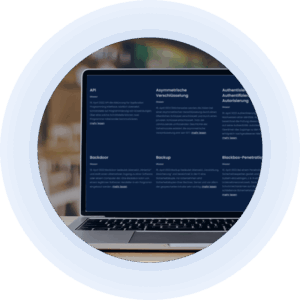
Der Begriff Scareware setzt sich zusammen aus dem englischen Wort „scare“, übersetzt Erschrecken, und dem Wortteil „-ware“ von Software. Bei Scareware handelt es sich um Programme, welche gezielt Schreckmomente auslösen und diese für Betrugsversuche nutzen. Zum Beispiel indem sie einen fiktiven Virenfund melden und ein kostenpflichtiges Programm zur Entfernung dieser angeblichen Viren anbieten. Scareware gehört zu den Schadprogrammen (Malware).
Das Prinzip von Scareware beruht auf einer psychologischen Gegebenheit: starke Emotionen wie z. B. Angst setzen das menschliche Urteilsvermögen herab. Deshalb versucht Scareware typischerweise, Angst auszulösen, z. B. durch:
Das Kalkül der Cyberkriminellen: aufgrund der ausgelösten Angst und dem Druck, schnell zu reagieren, handeln die angegriffenen Nutzer überstürzt. Sie verzichten auf Sicherheitsvorkehrungen und Überprüfungen, die sie normalerweise vornehmen würden. In der Folge laden sie potentiell schädliche Programme herunter oder überweisen Geld an die Cyberkriminellen.
Viele Fake-Antivirus und betrügerische Bußgeldforderungen sehen auf den ersten Blick seriös aus. Sie nutzen Logos, Schriften und Farben, die seriösen Virenscannern oder Behörden gleichen. Bei einer Überprüfung erweisen sie sich jedoch als gefälscht.
Scareware kann unterschiedliche Zwecke verfolgen:
>> Bei Scareware handelt es sich um Betrug, also um einen Strafbestand.
Prinzipiell kann es Ihnen an vielen Stellen begegnen:
Im Akutfall: Was auch passiert, ziehen Sie in Betracht, dass man Sie über Ihren Schreck gezielt manipuliert. Reagieren Sie daher besonnen und nicht über den befallenen Rechner:
Zur Prävention: Viele Maßnahmen zur Erhöhung der Cybersicherheit Ihres Unternehmens schützen auch vor Scareware. Besonders wichtig hinsichtlich Scareware ist die Sensibilisierung der Mitarbeitenden. Sie ermöglicht Ihren Mitarbeitenden, im Akutfall umsichtig zu handeln und Schaden von Ihrem Unternehmen abzuwenden. Zeigen Sie Ihren Mitarbeitenden Beispiele von typischen Scareware-Warnmeldungen, besprechen Sie ein festes Procedere für den Akutfall und üben Sie es gemeinsam ein.
Machen Sie allen Beteiligten klar:
Melden Sie einen Scareware-Vorfall bei der Meldestelle für Cyber-Sicherheit in Deutschland: https://www.allianz-fuer-cybersicherheit.de/Webs/ACS/DE/IT-Sicherheitsvorfall/Unternehmen/unternehmen.html?
The term scareware is a combination of the word ‘scare’ and the suffix ‘-ware’ from software. Scareware refers to programs that deliberately cause moments of fear and use them for fraudulent purposes. For example, they report a fictitious virus and offer a paid programme to remove these alleged viruses. Scareware is a type of malicious software (malware).
Scareware works by exploiting a psychological phenomenon: strong emotions such as fear impair people’s judgement. That is why scareware typically tries to trigger fear, e.g. through:
The calculation of cybercriminals: due to the fear triggered and the pressure to react quickly, the users who are attacked act rashly. They forego security precautions and checks that they would normally carry out. As a result, they download potentially harmful programs or transfer money to the cybercriminals.
Many fake antivirus programs and fraudulent fines appear legitimate at first glance. They use logos, fonts and colours that resemble those of reputable virus scanners or authorities. However, upon closer inspection, they turn out to be fake.
Scareware can serve different purposes:
>> Scareware is fraud and therefore a criminal offence.
In principle, you can encounter it in many places:
In an emergency: Whatever happens, bear in mind that you are being deliberately manipulated through your fear. Therefore, react calmly and do not use the infected computer:
Check the documented messages using other devices or your smartphone.
Prevention: Many measures to increase your company’s cyber security also protect against scareware. Raising employee awareness is particularly important when it comes to scareware. It enables your employees to act prudently in an emergency and prevent damage to your company. Show your employees examples of typical scareware warning messages, discuss a fixed procedure for emergencies and practise it together.
Make it clear to everyone involved:
Report a scareware incident to the Cyber Security Reporting Centre in Germany: https://www.allianz-fuer-cybersicherheit.de/Webs/ACS/DE/IT-Sicherheitsvorfall/Unternehmen/unternehmen.html?